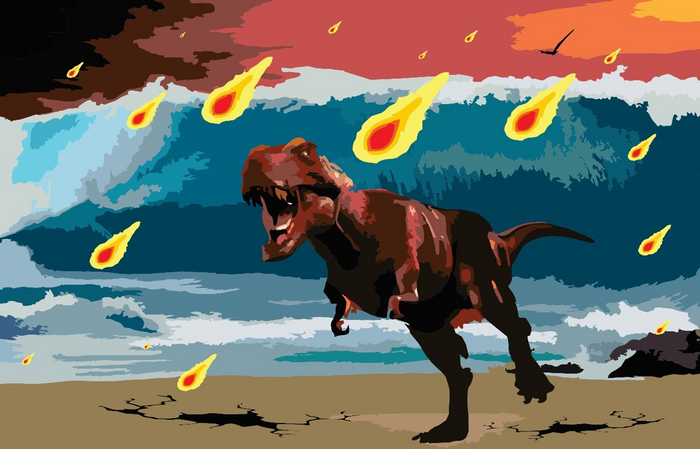Asteroid that killed the dinosaurs triggered “mega-earthquake” that lasted months
New evidence suggests that the Chicxulub impact also triggered an earthquake so massive that it shook the planet for weeks to months.

[Oct 8, 2022: Kea Giles, Geological Society of America]
Artwork by Hermann Bermúdez depicting one dinosaur’s experience of the Chicxulub impact. (CREDIT: Hermann Bermúdez)
66 million years ago, a 10-kilometer asteroid hit Earth, triggering the extinction of the dinosaurs. New evidence suggests that the Chicxulub impact also triggered an earthquake so massive that it shook the planet for weeks to months after the collision.
The amount of energy released in this "mega-earthquake" is estimated at 1023 joules, which is about 50,000 times more energy than was released in the magnitude 9.1 Sumatra earthquake in 2004.
Hermann Bermúdez will present evidence of this “mega-earthquake” at the upcoming GSA Connects meeting in Denver. Earlier this year, with support from a GSA Graduate Student Research Grant, Bermúdez visited outcrops of the infamous Cretaceous-Paleogene (K-Pg) mass extinction event boundary in Texas, Alabama, and Mississippi to collect data, supplementing his previous work in Colombia and Mexico documenting evidence of the catastrophic impact.
In 2014, while doing fieldwork on Colombia’s Gorgonilla Island, Bermúdez found spherule deposits—layers of sediment filled with small glass beads (as large as 1.1 mm) and shards known as ‘tektites’ and ‘microtektites’ that were ejected into the atmosphere during an asteroid impact.
Related Stories
These glass beads formed when the heat and pressure of the impact melted and scattered the crust of the Earth, ejecting small, melted blobs up into the atmosphere, to then fall back to the surface as glass under the influence of gravity.
The rocks exposed on the coast of Gorgonilla Island tell a story from the bottom of the ocean—roughly 2 km down. There, about 3,000-km southwest from the site of the impact, sand, mud, and small ocean creatures were accumulating on the ocean floor when the asteroid hit.
Layers of mud and sandstone as far as 10–15 meters below the sea floor experienced soft-sediment deformation that is preserved in the outcrops today, which Bermúdez attributes to the shaking from the impact.
Spherule deposits on Gorgonilla Island. (Credit: Hermann Bermúdez)
Faults and deformation due to shaking continue up through the spherule-rich layer that was deposited post-impact, indicating that the shaking must have continued for the weeks and months it took for these finer-grained deposits to reach the ocean floor. Just above those spherule deposits, preserved fern spores signal the first recovery of plant-life after the impact.
Bermúdez explains, “The section I discovered on Gorgonilla Island is a fantastic place to study the K-Pg boundary, because it is one of the best-preserved and it was located deep in the ocean, so it was not affected by tsunamis.”
Deformed spherule-rich layer at Gorgonilla Island (Colombia) showing that seismic activity persisted for weeks or months after impact. (Credit: Hermann Bermúdez)
Evidence of deformation from the mega-earthquake is also preserved in Mexico and the United States. At the El Papalote exposure in Mexico, Bermúdez observed evidence of liquefaction—when strong shaking causes water-saturated sediments to flow like a liquid.
In Mississippi, Alabama, and Texas, Bermúdez documented faults and cracks likely associated with the mega-quake. He also documents tsunami deposits at several outcrops, left by an enormous wave that was part of the cascading catastrophes resulting from the asteroid collision.
For more science stories check out our New Discoveries section at The Brighter Side of News.
Note: Materials provided above by Geological Society of America. Content may be edited for style and length.
Like these kind of feel good stories? Get the Brighter Side of News' newsletter.
Joseph Shavit
Head Science News Writer | Communicating Innovation & Discovery
Based in Los Angeles, Joseph Shavit is an accomplished science journalist, head science news writer and co-founder at The Brighter Side of News, where he translates cutting-edge discoveries into compelling stories for a broad audience. With a strong background spanning science, business, product management, media leadership, and entrepreneurship, Joseph brings a unique perspective to science communication. His expertise allows him to uncover the intersection of technological advancements and market potential, shedding light on how groundbreaking research evolves into transformative products and industries.



